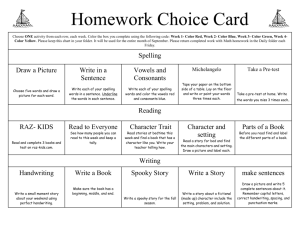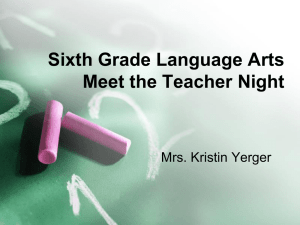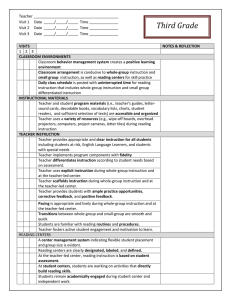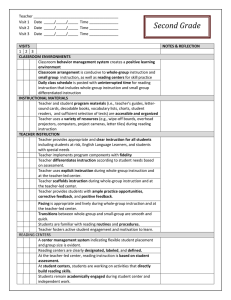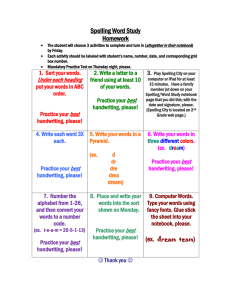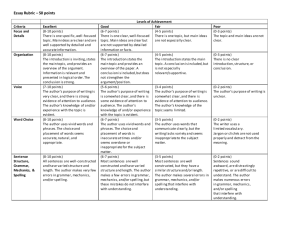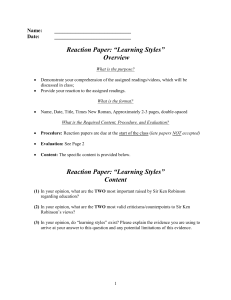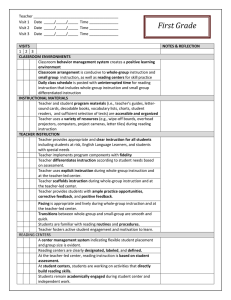Extra Chapter 4 RTI Presentation
advertisement
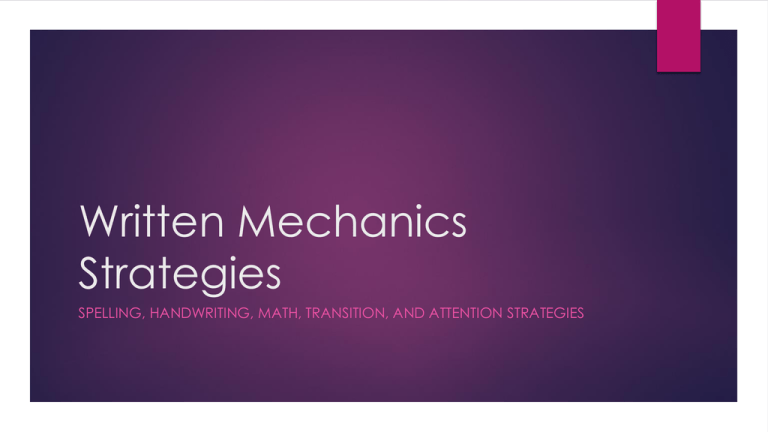
Written Mechanics Strategies SPELLING, HANDWRITING, MATH, TRANSITION, AND ATTENTION STRATEGIES Written Mechanics Strategies Written mechanics strategies are for students who struggle with the mechanics of writing. Examples of strategies that can be used are: to provide frequent reminders, help students find their own errors, model for the student how to find mechanical errors, use of peer editing, oral student and teacher writing (e.g., dictate), written correction, and; provide proof-reading checklists. Proofreading Checklists (S) – Space (P) – Punctuation (A) – Appearance (C) – Capitalization (E) – Error Analysis Activity (Dictate Sentences and Proofread) (1) Grab a partner; (2) Incorrectly copy sentences, exactly the way your partner says onto a piece of paper; (3) Allow your partner to identify your errors using the proofreading checklist; (4) Explain corrections to your partner; (5) Switch partners and repeat steps 1-4. Types of Strategies Spelling, Handwriting, Math, Transition, Attention and; Spelling Strategies Memorize high-frequency words; Air writing; Craft writing using glitter; Write in the sand; finger-painting; partnered back writing; use of individual chalkboards or whiteboards; magnetic letters; play games (e.g., Scrabble); computer spelling games; memory aids; and practice errors. Signs of Incorrect Hand-writing Unable to write in the lines; incorrect letter formation; disorganized written work; sloppy written work; unreadable writing; and, very slow writing. Handwriting Strategies Teach and model new letters; the requirement of correction of incorrect letters on assignments; teacher air writing demonstrations; flexibility with students’ letter formation; teacher observation; and, the providing of students with special materials (e.g., pencil grips, pencil types, and writing paper). Mathematics Strategies Strategies for aiding in student knowledge of mathematics include hands-on activities (e.g., pattern blocks, base-ten blocks, and interlocking cubes), graphing activities, and using non-textbook/nonworksheet type strategies. Repetition, or assigning students many problems does not work as well as providing support to students. A teacher should be present to help students understand the mathematical concepts. Examples of mathematical support assistance are “number square/5’s and 10’s” and “number squares/hundreds chart.” I have provided a hand-out. Transition Strategies The strategies include keeping students informed of schedule changes, teach the expected behavior for each transition, create a cue to inform students of the end of an activity, allow for ‘down-time’ prior to transition, be available to all students who will need help to transition, and provide class incentives when a great transition occurs. Attention Strategies Teach and Maintain Whole-Group Response Anytime a teacher needs to check a classroom of students for understanding, use a whole-group response. Maanum (2009) states, “whole-group responses help students to be actively involved in the learning process” (p. 198). Whole-group responses include the use of individual whiteboards or chalkboards, simultaneous answers, and the yes or no whole-class responses (e.g., thumbs up or down, red or green card, happy or sad face, etc.). Students who understand the assignment will stay on task. Also helpful is to give a manageable amount of work, set a time limit, and ensure a low sound level. Reference Maanum, J. L. (2009). Written mechanics strategies. In J. L. Maanum, The general educator’s guide to special education, 3rd Ed. (pp. 187199). Thousand Oaks, CA: Corwin.


